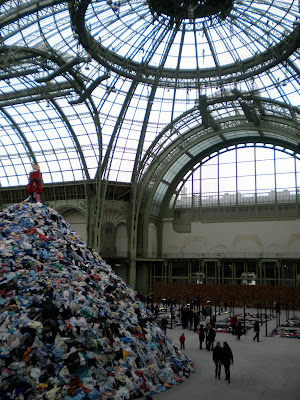La vie à Paris...la vie de l'haute culture. Parisian life...the life of high culture. There are countless aspects to life in Paris, or life in a big metropolitan city for that matter, that open your eyes to another world: one of art, culture, cuisine, experiences, and all together a different way of life. One major part of being in Paris are the expositions that happen practically on a weekly and monthly basis. For this post I chose to visit the MONUMENTA Exhibit at the Grand Palais (where Chanel Fashion Shows are!!!) for an exhibit featuring contemporary artist, Christian Boltanski for this year's 2010 MONUMENTA.

Working with a space of over 13,500m2, the Ministry of Culture gave Boltanski the amazing opportunity to come to Le Grand Palais and do what he wills and create a temporary masterpiece for all of Paris to experience. Born in 1944, France, Boltanski’s international career grew and established itself with great reputation since the 1970’s renowned in the contemporary scene. This year’s MONUMENTA is said to be ‘conceived as a powerful physical and psychological experience, an episode of spectacular emotion and sensations exploring the nature and meaning of human existence’. Wow, what the statement! The exhibit featured a combination of sound and vision building on the artist’s former themes of human existence and ‘being’. The vast hall of Le Grand Palais was lined with geometrically placed squares of clothing laid out in a grid like pattern. In the back center of the gallery was a monumental pile, more pyramid-like, pile of clothing with a large iron crane hovering above.
Surrounding the hall were large speakers belting great bass from them, odd sounds that filled and echoed the hall. Upon speaking with the representatives wandering around the exhibit engaging in conversation with people about the expo, we were informed that the strong bass sounds were of a heartbeat mixed with other internal sounds of the human body. Quite interesting! It gave it such a unique feeling and atmosphere that I really cannot begin to describe (see video below to see/hear it). Though the interesting part were the squares of laid out clothing; each square was surrounded by tiny speakers on metal framing, each of which were playing sounds of individual unique heart beats. Kind of cool! The mix of the large speakers and little speakers echoing through the hall created a most one of a kind sound environment.
Drawing your eyes to the large pyramid of clothing, you begin to hear the crane lowering down its claws to the clothes. It then clothes its teeth and grabs large pile of clothes, slowly rising to the ceiling again, then dropping the clothes, each falling like confetti, swirling about landing randomly around the pyramid. I don’t quite know exactly what this had to do with, but it was definitely a stunning visual experience of well, Monumental proportions. This extension of height really took advantage of the great space Boltanski was given to work with. If you ever visit Le Grand Palais in Paris, which I feel is a must, you too will be amazed by its vastness and glass and iron lattice ceiling.
Reviewed by both French and American press, MONUMENTA and Boltanski have succeeded in creating a truly phyical and mind bending experience. As the viewer of the exhibition, I feel that the French press gave a better, more approachable description of the exhibition. Where as the American review was more of an artistic review and critique. I appreciated the French press’ way of reviewing the exhibit for what it is worth, what people can get out of it, and what they can expect to see and feel if they attend. My favorite description of the exhibit, referred to it as ‘Vivant parmi les morts…’ In English: ‘Living among the dead’. This theme of the living dead for me was practically the first feeling I got when I entered the exhibit. As if each piece of clothing, among the thousands, was like a soul, lying there, a person once inside it. It may be a tad extreme of a thought, but seeing all the clothes and the numbered tin boxes, my mind immediately thought Holocaust. Perhaps not the artist’s intentions, but one must wonder, how can thousands of ‘tossed’ clothes not reference your mind to the Holocaust, even for me, the American from SoCal? Quite profound walking amidst what feels like the souls of yesterday.
«Il faut savoir regarder l'oeuvre de Boltanski avec la naïveté qu'elle appelle, ce sentiment de devoir se plonger tout entier dans un monde qui nous dépasse, un monde qui fait de la question existentielle une expérience immédiate, pleine et entière».
Anglais: “It is necessary to know to look at the work of Boltanski with the naivety which it calls, this feeling to have to plunge itself entire in a world which exceeds us, a world which makes existential question an immediate experiment”.





No comments:
Post a Comment